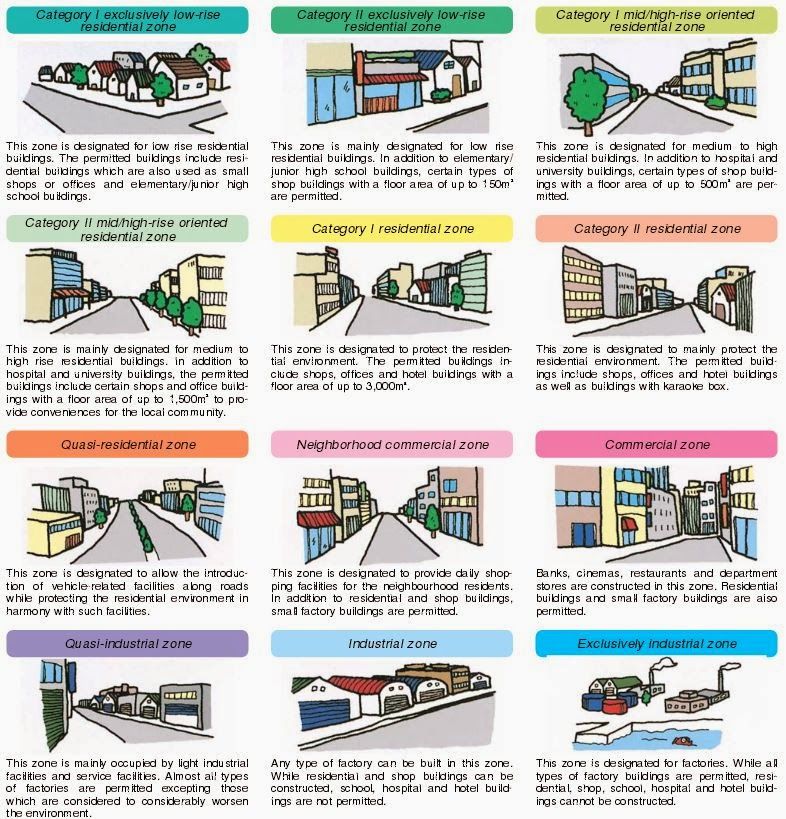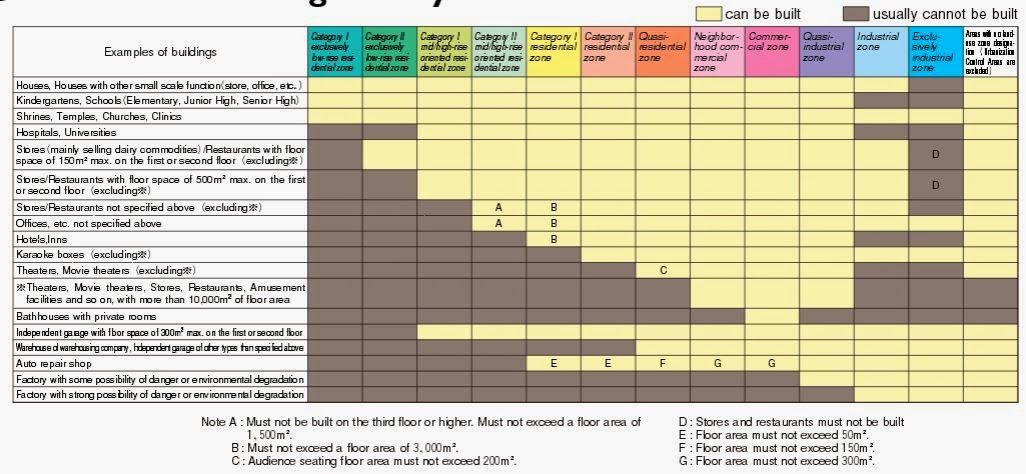North American vs Japanese zoning
May 30th, 2018
These notes come from reading two blog posts from the wonderful Urban Kchoze blog:
- Urban kchoze: Japanese zoning (here is the annotated and cached copy)
- Urban kchoze: euclidian zoning (here is the annotated and cached copy)
The Japanese system is inclusionary, as contrasted to the exclusionary system common here in the US. The typical zoning form in America is called euclidian zoning, which specifies the allowed uses and dimensions for a zone. Japan zones limit the "maximum nuisance" in a zone, and allow for any development below that threshold (e.g. a factory can’t be built in a residential neighborhood but housing can be built in a light industrial zone). You can think of this as whitelist vs blacklist approaches. The result in the Japanese case is a lot more mixed use development, while in the US land use is a lot more segregated.
Japanese zoning practices
- zoning is a national law, not a municipal by-law
- in the US, cities control their own zoning; but many cities (especially smaller ones) don’t have the expertise to plan a city decently
- in Japan, the national government mobilizes expertise to make a good set of laws
- local application is left to city governments, so cities have the execution power, but they have guidelines to work off of
- downside – fewer possibilities for experimentation
- there are only 12 zones
- range from low-rise residential zones to exclusively industrial zones
- in the US, there are often hundreds of different zones
 |
- zones allow a "maximum use" rather than an exclusive use for each zone
- the Japanese principle is to include all uses up to a maximum "nuisance level"
- every use considered less of a nuisance than the set zone is allowed, so low-nuisance uses are allowed everywhere
- as a result, almost all Japanese zones allow mixed use developments

- in N American zoning, a zone clearly specifies what is allowed in it (a sort of "whitelist" approach), and zones allow only one or two uses
- planning departments must micromanage the smallest detail – if they forget to zone for enough commercial zones or schools, they need to change the zoning later and therefore confront NIMBYs
- a lot of needed uses are forgotten => they then have to be built on the outskirts of the city

- hyper-competent micromanaging is much reduced in Japanese planning
- doesn’t differentiate different types of residential use
- N American zoning tends to treat single-family and multifamily as two separate uses to keep segregated
- in Japan, if a building is used to provide a place to live to people, it’s residential, that’s all – whether it’s rented, owned, houses one or many households, it doesn’t matter
- maximum ratios of building to land areas still restrict how high and how dense residential buildings may be, so you’re not going to get a 10-story apartment block in the middle of single-family houses
- in American cities, if the planning department doesn’t plan for enough multifamily or single-family zones, you can create big problems
- there may be shortages of either multifamily or single-family zones, pushing prices up for that kind of housing
- in practice, it’s most often rental units that get the shaft, resulting in sky-high rents as there is a rental unit crisis (ahem, San Francisco…)
- in Japan, multifamily homes tend to congregate around schools, commercial sectors or train stations. This makes sense, because the $$ per square foot of land of multifamily uses is higher than for single-family homes
- rational rather than arbitrary height limits
- the farther a building is set back from the street and the wider the street, the higher it can be
- rules sometimes omitted when they want to build higher buildings
- in the US, rules are often determined by what’s already in the neighborhood
- cities have the right to make exceptions, require certain geometric criteria, etc
- but the defaults are set by the national government
- results
- the Japanese model has created/protected urban settings that are far more people focused and walkable
- much more market-based, responsive to demand
- this isn’t the only model
- e.g. New Urbanists push for form-based zoning to favor walking and to allow mixed-use developments

American zoning practices: Euclidian zoning
- a typical American suburb comprises blocks of nearly identical single-family homes
- this is not an emergent phenomenon, where individuals just happened to all choose to build their homes in the same way
- zoning defines and strictly limits urban developments
- in N America, the typical standards are what is called "euclidian zoning" (from the city of Euclid, Ohio)
- extremely strict
- considers single- and multi-family homes to be two separate uses to separate, as are semi-detached houses and fully detached houses (contrasted against European and Asian zoning, which consider residential as residential)
- originates from racial segregation
- at first, zoning explicitly banned certain races
- when it was ruled unconstitutional, they used different ways to achieve the same result
- minorities were disproportionately poor — more likely to rent, and when they were owners they tended to buy smaller homes => so zoning (a) banned multifamily buildings in single-family areas and (b) established minimum lot and building sizes
- greatly limits density
- why?
- simple to enforce – simply measure dimensions and see if they conform to the rules
- satisfies those with a desire to control the built area of their immediate neighborhood, but terrible for macro-management of decent communities
- the neighborhood doesn’t change much once it’s built up => NIMBYs love it
- consequences
- delays/kills projects => strangles redevelopment and "keeps neighborhoods in formaldehyde", effectively makes change illegal
- ultimate empowerment tool for NIMBYs
- ironically, it means that the only time it’s worth it for developers to confront NIMBYs is to build condo towers, because the profit of denser units justifies fighting for it
- yet duplexes/rowhouses/etc would be a better, more gradual evolution
- results in sprawl; easier to build out than densify
- if the land is reserved only for single-family detached houses, then the profit value of each square foot is kept artificially low
- oversupply of single-family lots
- shortage of land for multifamily and commercial development
- encourages corruption
- when zoning blocks a highly profitable project, you need a zoning modification to let it through
- developers have an incentive to buy off elected officials
 |  |
Keep in touch!